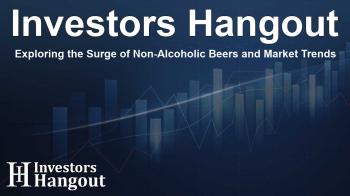Exploring the Surge of Non-Alcoholic Beers and Market Trends

The Growth of the Non-Alcoholic Beer Market
The non-alcoholic beer industry has experienced remarkable growth in recent years as consumers become more health-conscious. With global sales recorded at USD 20,524.5 million, this segment is projected to reach USD 43,926.9 million by the end of 2034, showcasing a compound annual growth rate (CAGR) of 7.9%. This significant growth is attributed to changing consumer preferences and the rise of a zero-proof lifestyle.
Health Awareness Drives Consumer Choices
Health issues associated with alcohol consumption have prompted many consumers to seek alternatives that offer the familiar taste of beer without the harmful effects of alcohol. Recognizing this trend, numerous manufacturers have started producing innovative alcohol-free beers that mimic traditional flavors while maintaining a low alcohol content (less than 0.5% ABV) or being entirely alcohol-free.
Innovative Brewing Techniques
Crafting these beverages involves a range of methods, including dealcoholization and blending. Leading brands like Heineken and Carlsberg have embraced these techniques to cater to health-conscious consumers.
Consumer Behavior Shifts
According to market insights, consumer choices for non-alcoholic beers are influenced by various factors such as time of day, social settings, and personal habits. This reflects a broader acceptance of alcohol-free options in various contexts, including social gatherings and fitness activities.
Reasons for Increasing Popularity
Research indicates that non-alcoholic beers offer several health benefits, including improvements in cardiovascular health due to polyphenols found in hops, which can help lower blood pressure and inflammation. Furthermore, these beverages have been linked to reduced anxiety levels, making them an appealing alternative for many consumers.
Challenges in the Market
Despite its growth, the non-alcoholic beer market faces challenges. Dealcoholized beverages may sacrifice certain qualities like aroma and flavor, leading to consumer hesitation. Additionally, higher production costs related to crafting these specialty drinks can hinder sales and market acceptance.
Emerging Opportunities in the Non-Alcoholic Beverage Sector
New marketing strategies targeting the wellness movement have opened up lucrative opportunities for manufacturers. As consumers become more aware of the health impacts of alcohol, the demand for non-alcoholic alternatives is expected to rise. Stringent alcohol regulations in some countries also pave the way for increased sales of alcohol-free products.
The Influence of the Zero-Proof Movement
The popularity of the zero-proof movement, which advocates for reduced alcohol consumption, continues to reshape the landscape of beverage choices, leading many to explore non-alcoholic options for social occasions.
Artisanal and Craft Non-Alcoholic Beers
The growth of artisanal and craft non-alcoholic beers adds another layer to the market. Urban consumers, particularly in metro areas, seek out these options for their unique flavors and quality, indicating a shift toward premium, craft options.
Regional Market Insights
The growth trajectory varies by region. In North America, particularly the USA, the market is thriving, driven by health consciousness and changing drinking habits. The demand for non-alcoholic beer in the USA is expected to exhibit a CAGR of 7.1%, reaching USD 5,534.8 million by 2034.
Growth in Europe
Europe, particularly Germany, holds a strong position in the non-alcoholic beer sector, fueled by a long-standing beer culture and consumer inclination towards healthier choices. The projected CAGR in Germany is 6.8%, with expected sales of USD 3,733.8 million by 2034.
Future of Non-Alcoholic Beer
The non-alcoholic beer industry is not only experiencing growth but is also innovating to meet consumer demands for diverse flavors and healthier options. As more brands enter the market with unique offerings, the future looks promising. Consumer education about the benefits of non-alcoholic beer will also play a critical role in driving acceptance and expanding the market.
Frequently Asked Questions
1. What is driving the growth of the non-alcoholic beer market?
Consumer health consciousness and a shift towards mindful drinking are the main drivers of growth in the non-alcoholic beer market.
2. How does non-alcoholic beer benefit health?
Non-alcoholic beer can improve cardiovascular health due to polyphenols and help reduce anxiety levels.
3. What are the main challenges faced by the market?
Challenges include maintaining flavor quality during production and higher costs associated with specialty craft options.
4. Why is the zero-proof movement significant?
The zero-proof movement promotes health and well-being, encouraging consumers to choose alcohol-free beverages for social settings.
5. What is the future outlook for non-alcoholic beer?
The market is expected to continue growing, bolstered by innovations, diverse flavors, and increasing consumer acceptance across different regions.
About The Author
Contact Riley Hayes privately here. Or send an email with ATTN: Riley Hayes as the subject to contact@investorshangout.com.
About Investors Hangout
Investors Hangout is a leading online stock forum for financial discussion and learning, offering a wide range of free tools and resources. It draws in traders of all levels, who exchange market knowledge, investigate trading tactics, and keep an eye on industry developments in real time. Featuring financial articles, stock message boards, quotes, charts, company profiles, and live news updates. Through cooperative learning and a wealth of informational resources, it helps users from novices creating their first portfolios to experts honing their techniques. Join Investors Hangout today: https://investorshangout.com/
The content of this article is based on factual, publicly available information and does not represent legal, financial, or investment advice. Investors Hangout does not offer financial advice, and the author is not a licensed financial advisor. Consult a qualified advisor before making any financial or investment decisions based on this article. This article should not be considered advice to purchase, sell, or hold any securities or other investments. If any of the material provided here is inaccurate, please contact us for corrections.

